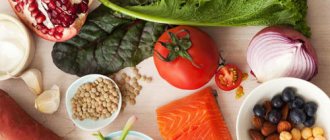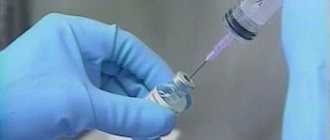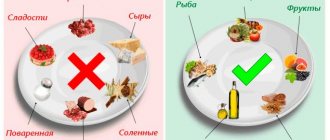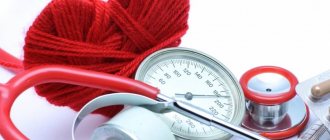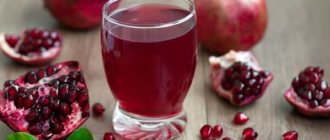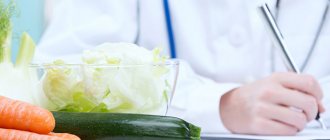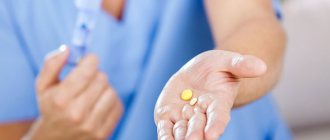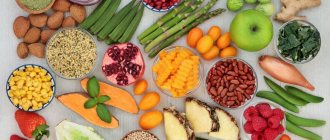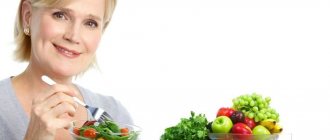Atherosclerosis, damage to large vessels and arteries, ischemia, heart attack, angina, stroke - this is only an incomplete list of the consequences that high cholesterol leads to, not to mention poor health. In addition to drug treatment and folk remedies, nutrition plays an important role in therapy for this pathology.
You need to know how to distribute essential nutrients (BJU) among different meals, how to create a menu, which foods to exclude from it, and which, on the contrary, to focus on. As practice shows, organizing a proper diet for hypercholesterolemia is the key to recovery and reducing the risk of developing the above complications.
There is a special diet for high cholesterol, which allows you to organize nutrition so that it becomes part of the treatment program.
The essence
Brief description of the diet. Type: therapeutic, hypolipidemic. Duration: until cholesterol levels normalize or for life if hypercholesterolemia is chronic or there is a predisposition to it. Results: keeping LDL concentration in the blood within normal limits, minimizing complications. Difficulty: medium.
For high cholesterol, a diet is prescribed, which is characterized by the following features:
- constant monitoring of daily caloric intake;
- compliance with the principles of proper nutrition;
- optimal balance of all nutrients necessary for the body (BJU);
- using the characteristics of a balanced diet: taking into account climate, concomitant diseases (hypertension, Gilbert's syndrome, obesity, diabetes), age, cholesterol level, gender differences, degree of complications.
The main feature of the diet is its therapeutic effect. It is intended primarily to normalize well-being and reduce the risk of complications. Therefore, first you need to consult with a specialist (therapist, cardiologist, phlebologist) to clarify the diagnosis, and then, with the test results and doctors’ conclusions, contact a nutritionist who will help you create the right menu. Subsequently, based on it, you can develop your own version of the diet.
How to cope with weight loss
Many people lose weight during chemotherapy. It is important to prevent severe exhaustion. Preference should be given to foods with a high calorie content: high in fat, high in sugar.
Tips to help increase your calorie intake:
- Buy dairy and other high-fat products.
- Consume baked goods regularly.
- Drink liquids that are high in calories, such as sweet fruit juices and hot chocolate.
- Add more sugar, butter and vegetable oil to dishes that you prepare yourself.
- Eat these dishes with bread.
- Dress salads with high-calorie sauces.
- Carry energy bars with you.
- Always have a snack on hand - not only at home, but also at work or on a walk.
Peculiarities
The diet takes into account the gender and age characteristics of the patient.
Gender
High cholesterol in women is associated primarily with their cravings for sweets, constant weight fluctuations (either dieting or overeating) and hormonal changes. Therefore, a lipid-lowering diet for them is based on limiting complex carbohydrates and prohibiting any fasting. In addition, it is compiled taking into account pregnancy, the postpartum period and the onset of menopause after 45-50 years. The most difficult thing is to give up cakes, ice cream, sweets, pastries, and fast food.
The advantage of this therapeutic nutrition system for women is the availability of an option for overweight. It allows you to reduce your daily caloric intake to the permitted level and keep your body weight under control without strict restrictions.
High cholesterol in men is usually diagnosed due to abdominal obesity, physical inactivity, and abuse of fatty and salty foods. Therefore, a lipid-lowering diet categorically prohibits them from drinking alcoholic drinks with high-calorie snacks, and also recommends that they simultaneously exercise, but in moderation, according to a separate program.
Age
If high cholesterol is diagnosed in a child, a lipid-lowering diet is prescribed to him with great caution and only with strict adherence to all the specialist’s recommendations. Despite the fact that for adults it involves a significant restriction of fats, in childhood this is unacceptable, as it will negatively affect the development of the nervous system. Therefore, the same dairy products should remain in the diet completely. But fast food and sweets should be limited (you shouldn’t ban them at all), finding healthy alternatives for them.
The same applies to those who were diagnosed with high cholesterol after 50 years of age. Restrictions should be approached with extreme caution, otherwise you can harm your health. The risk of diabetes also increases at this age. Therefore, you need to constantly monitor your blood glucose levels and take into account the glycemic index of foods when choosing a menu.
How to deal with constipation
Constipation occurs due to decreased intestinal tone. The main problems: the stool is too hard, has a small volume, comes out only with significant straining, or the frequency of bowel movements is significantly reduced.
You can cope with constipation without enemas or medications, through nutrition. You need to increase your intake of just two nutrients:
- water (or other liquid) – at least 2 liters per day, up to 3 liters is possible;
- fiber - at least 30 g per day, and more if necessary (it is found in vegetables, fruits, cereals, whole grains).
Dietary supplements can also be used as a source of fiber: for example, microcrystalline cellulose. It's important to drink plenty of fluids, as increasing your fiber intake "dry" can make constipation worse.
Reminders
For those who are prescribed a diet against high cholesterol, the attending physician usually issues accompanying instructions. They reflect the basic principles of nutrition for this pathology. They must be followed strictly if there is a desire to recover.
Important note. The numbers in the instructions may vary, as the doctor and nutritionist adjust them depending on the individual course of the disease.
Product reminder:
- Fruits are eaten fresh every day, preferably seasonal ones. Make homemade juices from them.
- Vegetables - fresh, as well as stewed, baked, steamed and boiled. According to the season. Make homemade juices from them (without adding spices and salt).
- Legumes - 2 times a week.
- Meat - not fatty (beef, veal, turkey, chicken, rabbit) and not fried.
- Dairy products - low-fat or low-fat.
- Vegetable oil is for dressing salads; you cannot fry with it. Cold pressed. The daily norm is 2 tbsp. l.
- Salt - 5 g per day.
- Sugar - 50 g.
Nutrient Reminder:
- Complex carbohydrates - 400 g per day. Limit simple ones to a minimum. The basis is cereals.
- Proteins - 70 g. Animal to vegetable ratio: 50/50.
- Fats - 70 g. Animal to vegetable ratio: 35/65.
Nutrition reminder:
- The size of one serving is determined based on the presence/absence of excess weight and daily calorie content.
- Fractional 6 meals a day.
- Approximate diet: breakfast (7:00), lunch (10:30), lunch (14:00), afternoon snack (16:30), dinner (18:30), before bed (22:00).
- Dishes must be fresh and prepared daily.
- The daily water requirement is 1.5 liters.
First, you will have to spend some time looking at the lists of allowed and prohibited foods, the standard menu, weighing everything (kitchen scales are necessary), calculating the optimal daily caloric intake for your height and body weight, and dealing with many other issues reflected in these instructions. However, soon you will develop the necessary skills (learn to determine the serving size “by eye”, create your own version of the diet with alternative dishes, etc.) and the body will get used to such a healthy diet.
For a month
The duration of such a diet is agreed with the doctor and usually does not exceed 12 days. However, in exceptional (!) cases, the nutrition system can be adjusted by a specialist and extended for another 2 weeks. In this case, an approximate diet for the month will be compiled by a nutritionist taking into account the results of a blood test, body mass index, age, and other indicators.
Under no circumstances should you decide to increase its term on your own! This can lead to negative consequences and detrimental health results.
If desired, the list of dishes can be changed based on your individual preferences. Nutritionists recommend adjusting the menu taking into account the table of cholesterol content in foods.
Table of cholesterol content in food (mg per 100 grams)
Oils and fats
| Product | Cholesterol content |
| melted butter | 280 |
| fresh butter | 240 |
| "peasant" butter | 180 |
| beef fat | 110 |
| pork or lamb fat | 100 |
| rendered goose fat | 100 |
| pork lard | 90 |
| vegetable oils | 0 |
| margarines based on vegetable fats | 0 |
Milk and dairy products
| Product | Cholesterol content |
| cream 30% | 110 |
| sour cream 30% fat | 90-100 |
| cream 20% | 80 |
| fat cottage cheese | 40 |
| cream 10% | 34 |
| sour cream 10% fat | 33 |
| raw goat milk | 30 |
| cow's milk 6% | 23 |
| cottage cheese 20% | 17 |
| milk 3-3.5% | 15 |
| milk 2% | 10 |
| full fat kefir | 10 |
| regular yogurt | 8 |
| milk 1% | 3.2 |
| kefir 1% | 3.2 |
| serum | 2 |
| low fat yogurt | 1 |
| low fat cottage cheese | 1 |
Meat, meat products
| Product | Cholesterol content |
| brain | 800 — 2300 |
| kidneys | 300 — 800 |
| chicken liver | 492 |
| beef liver | 270-400 |
| pork, loin | 380 |
| pork knuckle | 360 |
| chicken heart | 170 |
| veal liver sausage | 169 |
| beef tongue | 150 |
| liver pate | 150 |
| pork liver | 130 |
| raw smoked sausage | 112 |
| pork | 110 |
| roe deer meat back, leg, back | 110 |
| sausages | 100 |
| sausages in jars | 100 |
| white Munich sausage | 100 |
| lean veal | 99 |
| lean lamb | 98 |
| fatty beef | 90 |
| rabbit meat | 90 |
| duck with skin | 90 |
| skinless chicken dark meat | 89 |
| goose | 86 |
| smoked mortadella | 85 |
| salami | 85 |
| Vienna sausages | 85 |
| cervelat | 85 |
| skinless chicken white meat | 79 |
| horsemeat | 78 |
| lamb (summer) | 70 |
| lean beef | 65 |
| venison | 65 |
| skinless duck | 60 |
| boiled fatty sausage | up to 60 |
| pork tongue | 50 |
| broilers 1st category | 40 — 60 |
| chick | 40 — 60 |
| turkey | 40 — 60 |
| boiled sausage | up to 40 |
Fish, seafood
| Product | Cholesterol content |
| Pacific mackerel | 360 |
| stellate sturgeon | 300 |
| cuttlefish | 275 |
| carp | 270 |
| marble natoteniya | 210 |
| acne | 160 — 190 |
| oysters | 170 |
| shrimps | 144 |
| sardines in oil | 120 — 140 |
| pollock | 110 |
| herring | 97 |
| mackerel | 95 |
| medium fat fish (up to 12% fat) | 88 |
| crabs | 87 |
| mackerel | 85 |
| mussels | 64 |
| trout | 56 |
| fresh tuna (canned) | 55 |
| low-fat fish (2 - 12%) | 55 |
| shellfish | 53 |
| sole | 50 |
| pike | 50 |
| cancer | 45 |
| horse mackerel | 40 |
| cod | 30 |
Cheeses
| Product | Cholesterol content |
| Gouda cheese - 45% | 114 |
| cream cheese fat content 60% | 105 |
| Chester cheese - 50% | 100 |
| Camembert cheese - 60% | 95 |
| Emmental cheese – 45% | 94 |
| processed cheese – 60% | 80 |
| processed cheese "Russian" | 66 |
| Camembert cheese - 45% | 62 |
| Edam cheese - 45% | 60 |
| Tilsit cheese – 45% | 60 |
| smoked sausage cheese | 57 |
| cheese "Kostroma" | 57 |
| processed cheese - 45% | 55 |
| Camembert cheese - 30% | 38 |
| Tilsit cheese - 30% | 37 |
| Edam cheese - 30% | 35 |
| processed cheese - 20% | 23 |
| Limburg cheese - 20% | 20 |
| Romadour cheese - 20% | 20 |
| sheep cheese - 20% | 12 |
| homemade cheese - 4% | 11 |
| homemade cheese - 0.6% | 1 |
Egg
| Product | Cholesterol content |
| quail egg (100 g) | 600 |
| whole chicken egg (100 g) | 570 |
Product table
One of the most important points in the diet for people with high cholesterol is to strictly adhere to two lists. These are permitted and prohibited products. The first group includes those that are not just good for health and promote weight loss, but primarily have hypolipidemic properties, that is, they reduce the level of bad LDL in the blood. The second includes those that, on the contrary, increase their concentration, and also mostly refer to unhealthy foods that provoke the appearance of excess weight.
For convenience, the lists are presented in the form of a table; the products are divided into food categories, so they will be easy to find.
What is cholesterol
Cholesterol is a type of lipid present in the cells of animals and humans. The body synthesizes the bulk, and about 20% comes from food. Cholesterol is necessary for a person if it does not exceed the permissible norm, because it:
- strengthens cell membranes;
- participates in digestion;
- normalizes hormonal levels;
- provides protection to nerve fibers;
- reduces cellular permeability;
- Helps the body produce vitamin D.
In other words, a person needs cholesterol so that he can survive. But it is important to distinguish between “good” cholesterol and “bad” cholesterol.
Diet options
For cardiovascular diseases, a standard diet is prescribed - treatment table number 10 according to Pevzner. It is also recommended for high bad cholesterol, which is the main provocateur of the development of CVD. However, you need to keep in mind that within it there is a separate classification for more refined diagnoses. Therefore, if hypocholesterolemia is accompanied by a number of other pathologies, you need to look at this gradation.
All diet options No. 10 are similar to each other and differ only in the following points:
- 10A - low fat;
- 10B - protein-carbohydrate;
- 10C - maximum balanced;
- 10P - low carbohydrate diet;
- 10G - salt-free;
- 10I - drinking.
A more detailed description of the options for diet No. 10 is shown in the table below.
Most often, for high cholesterol, treatment table No. 10C is prescribed, which has a hypolipidemic effect. It, in turn, is divided into two more options - with obesity and without it.
How to deal with diarrhea
Diarrhea is associated with the secretion of water into the intestinal lumen under the influence of drugs. Medicines will help cope with diarrhea itself. The goal of nutrition is to prevent dehydration. You need to drink at least 2 liters of liquid daily. With long-term diarrhea, you lose not only water, but also electrolytes, so it is better to buy an oral rehydration solution at the pharmacy. This is a powder that is diluted in a large volume of water and consumed orally to restore water and electrolyte balance against the background of diarrhea.
Another mechanism of diarrhea is increased intestinal motility. If possible, you should avoid irritating him. To do this, do not eat too hard (raw vegetables, seeds), hot or cold foods. By the time the bolus of food reaches the intestines, its temperature will be close to body temperature. However, irritation of the upper digestive tract also reflexively affects intestinal tone.
Other recommendations:
- Against the background of diarrhea, it is undesirable to eat too fatty foods. It stimulates the release of bile. In turn, bile acids stimulate the intestines.
- Do not drink coffee and strong tea - these drinks contain caffeine and theine, which have pharmacological properties. Their effects include intestinal stimulation.
- Don't eat too much spice - it causes chemical irritation to the intestinal wall.
Take a course of chemotherapy with original drugs
- Remote consultation
- We will select the best treatment for you
Call me back!
Sample menus
To lower high cholesterol, you need to focus on the sample menu for the above options for treatment table No. 10. It will help you understand the principle of preparing a diet, and in the future you can do it yourself, selecting alternatives to some dishes in accordance with your taste preferences.
Table No. 10
Prescribed for various cardiovascular diseases, which are characterized by circulatory failure. This condition is often caused by high cholesterol. Since this table is the main one, you need to know how to eat properly on it.
A sample menu for the week will help you navigate the choice of dishes and products. In some versions of diet No. 10, soups are prohibited. So, if you are not accustomed to them, they can be replaced without any damage to health with side dishes made from durum wheat cereals or pasta.
Table No. 10C
Prescribed for high cholesterol and already diagnosed atherosclerosis. Diet No. 10C reduces the level of low-density lipoproteins in the blood, cleanses blood vessels and destroys atherosclerotic plaques.
A sample menu for 3 days will allow you to correctly create your own diet. It is designed for a daily calorie content of 2000-2200 kcal, that is, with high cholesterol against the background of overweight and obesity. If there is no such problem, you should raise the bar to 2500-2700 kcal by adding permitted sweets (dried fruits, sweet fruits and berries, honey, homemade desserts) and increasing potatoes in the diet.
Table No. 10G
This diet is prescribed for hypertension, which, in turn, is a frequent accompaniment of high cholesterol. Designed to simultaneously reduce both. When compiling a diet, you can focus on an approximate menu for 3 days.
Advantages and disadvantages
| pros | Minuses |
|
|
Recipes
For breakfast. Barley porridge
If you have high cholesterol, you should eat only well-steamed cereals. Therefore, it is recommended to soak them in warm water in the evening so that they are properly boiled in the morning. Rinse 300 g of pearl barley several times, pour warm water so that it completely covers the barley. Leave overnight.
In the morning, drain the water and rinse again. Pour water into the barley in a ratio of 2 to 3. After boiling, reduce the heat to low, do not open the lid and cook the porridge for 40 minutes. Then, without opening the lid, turn off the stove and leave it to steep for 20 minutes.
At this time, boil 100 ml of 1.5% milk, chop some apples and oranges, chop 10 g of walnuts. Place the required portion of barley on a plate, pour hot milk, sprinkle with fruits and nuts. Instead of butter, it is better to use any vegetable oil, replace sugar with honey.
On the first. Buckwheat soup
Sort, rinse and fry 100 g of buckwheat in a dry frying pan. Boil by adding 1 tbsp to water. l. any cold pressed vegetable oil. In 20 minutes. Place 200 g of diced potatoes, 50 g of grated carrots, chopped onion and a little parsley root (20 g) into water. Cook for another 15 minutes. Before serving, top the soup with chopped garden herbs.
On to the second. Steamed vegetable cutlets
Grind 2 oven-baked and cooled potatoes onto a coarse grater, 3 carrots and 2 beets (medium sized) into a fine grater. Squeeze the juice from the resulting carrot and beet puree and remove it. Grind 1 onion and 4 pcs. prunes Mix all ingredients. Add 30 g of semolina flour to bind the mass. Knead thoroughly. Do not add salt. Form small cutlets. Roll them in sesame seeds. Place in a steamer. Time - 30 min.
Salad. Fish under a fur coat
Boil 150 g of potatoes, carrots and beets, 3 eggs, 200 g of any sea fish fillet (whichever you like best). Peel 2 onions, chop them and sauté for 7 minutes. over low heat. Grind the vegetables on a coarse grater, and the egg white on a fine grater. Cut the fish into small pieces.
For dressing, instead of mayonnaise, prepare a separate sauce: mix 100 g of 10% sour cream and 50 g of lemon juice. Place the ingredients on a flat and wide dish in layers: potatoes - fish - onions - coat with dressing - beets - carrots - coat with dressing - repeat all layers again. Sprinkle egg white on top and garnish with parsley leaves.
Dessert. Fruit salad
Peel, core and pit 1 red apple, 2 apricots, 100 g pineapple, 50 g orange. Prepare 50 g of pomegranate seeds and 30 g of chopped walnuts. Cut the fruits into small cubes and mix them. Place in portioned salad bowls, pour over lemon juice, sprinkle with pomegranate seeds and walnuts on top.
Bakery. Curd cookies
Store-bought baked goods are prohibited if you have high cholesterol, but homemade baked goods can be included in your diet once a week. It should be remembered that margarine and butter are strictly prohibited.
Mix 100 g of low-fat cottage cheese, 200 g of oatmeal (you can prepare it yourself by chopping regular flakes). After thoroughly kneading, add 2 tbsp. l. warm water and the same amount of vegetable oil. For a sweet taste, you can add 1 tsp. honey or 2 tbsp. l. orange zest. Form cookies, place on a baking sheet, previously greased with a small amount of vegetable oil. Bake in the oven at 180°C. Time - 10 min.
Beverages. Hot toddy
Brew large-leaf natural black tea in a ceramic teapot. In 10 minutes. pour it into a cup (200 ml). It is important that it is hot and strong. Add 50 ml of freshly squeezed lemon juice, 50 ml of vanilla syrup, a circle of lemon, a pinch of cloves and cinnamon. Mix. To cover with a lid. Drink after 5 minutes.
Juice therapy
In addition to special nutrition, nutritionists have also developed a method for reducing the overall level of fats in the blood by drinking juices according to a special scheme.
The duration of the course is 5 days. During this time, in the morning, on an empty stomach, you need to drink fresh juice (freshly squeezed juice).
First day: 70 ml celery juice and 130 ml carrot juice.
Second day: mix 70 ml of beet juice with 100 ml of carrot juice and 70 ml of cucumber juice.
Beetroot juice must be squeezed out 1.5-2 hours before consumption.
Third day: mix 70 ml apple juice and 70 ml celery juice with 130 ml fresh carrot juice.
Fourth day: add 70 ml of apple juice to 130 ml of carrot juice.
Fifth day: 130 ml orange juice.
Juice therapy can reduce TC by 10% and lose a little weight.
Individual cases
High cholesterol is considered the main cause of various cardiovascular diseases. Therefore, it is often accompanied by various health problems. In this case, you need to keep in mind what food restrictions and diets there are for diagnosed pathologies in order to be able to combine them with each other. This is quite difficult, so at first you cannot do without consulting doctors and nutritionists.
For thick blood and high cholesterol
Diagnosis: hyperviscose syndrome.
The basic rule of the diet: increase water consumption to 2 liters per day.
The basis of the diet are foods that thin the blood and at the same time reduce high cholesterol:
- tomatoes;
- fatty sea fish, kelp, fish oil;
- oils: sunflower, pumpkin, olive, nut;
- sour berries: gooseberries, currants, cranberries, viburnum, lingonberries, blueberries;
- sour fruits: all citrus fruits, kiwi;
- ginger;
- peanuts, hazelnuts;
- low-fat kefir, yogurt, ayran;
- honey;
- flax-seed.
Some foods that thicken the blood cannot be completely excluded from the diet, since many of them are beneficial for the body, but in case of such pathology it is worth limiting them (up to 1-2 times a week in small quantities):
- buckwheat;
- bananas;
- chokeberry.
But most products that thicken the blood are harmful to the body and increase bad cholesterol, so you should forget about them in case of such a disease:
- fatty meat (lamb, pork, goose, duck), lard, sausages;
- fried foods, smoked meats;
- margarine;
- whole village milk, butter, cream, sour cream;
- fast food;
- refined sugar;
- white bread, pastries, muffins;
- lemonade.
For high sugar and cholesterol
Diagnosis: diabetes mellitus.
Therapeutic diet: table No. 9.
The basic rule of the diet: for type I diabetes mellitus, create a menu based on the table of bread units; for type II diabetes mellitus - guided by the glycemic index table.
Sugar-lowering foods that you need to focus on in this diet:
- cabbage and grapefruit juices;
- the grapefruit itself;
- chicory drink;
- Jerusalem artichoke;
- herbal teas with the addition of ginseng and eleutherococcus (possibly with pharmaceutical tinctures), rose hips, St. John's wort flowers, dandelion roots, nettle leaves;
- flaxseeds (can be ground and added to porridges and cocktails);
- celery greens, asparagus, parsley;
- horseradish (not in the form of a spice, but the root, grated at home), onions (for high cholesterol, only boiled), garlic.
First of all, everything sweet is prohibited. You will have to exclude from the diet even those sweets that are allowed on the menu of treatment table No. 10.
With increased bilirubin and cholesterol
Diagnosis: Gilbert's syndrome.
Therapeutic diet: table No. 5.
The basic rule of the diet: increase water consumption to 2.5 liters per day, eliminate salt and alcohol from the diet.
The menu should focus on products that reduce elevated levels of bile pigment (bilirubin) and at the same time are useful for hypercholesterolemia. These include:
- sweet fruits: persimmons, grapes, bananas, figs, lychees, pomegranate, mango, red apples;
- low-fat dairy products;
- chicken, turkey;
- vegetable soups;
- cereal porridge;
- egg white;
- herbal teas (birch, St. John's wort, chamomile).
You need to avoid foods that increase stomach acidity:
- radishes, onions, mushrooms, sorrel;
- citrus;
- confectionery products with soda and baking powder;
- seafood;
- sweets;
- red meat;
- canned food;
- vinegar, store-bought sauces;
- coffee, alcohol.
Herbs to Lower Cholesterol
Herbal medicine is designed to complement the diet and reduce cholesterol levels significantly.
- Linden flowers strengthen blood vessels and reduce cholesterol thanks to a bouquet of essential oils. It is useful to brew linden blossom and drink it instead of tea.
- Flax seeds will help reduce bad cholesterol by as much as 15%. You can consume them by adding them to food. It is also an excellent means of preventing atherosclerosis.
- Lemons reduce atherogenic lipids and increase high-density lipoproteins. Thanks to this, cholesterol levels decrease and the person feels cheerful.
- Turmeric improves lipid metabolism and reduces “bad” cholesterol by more than 51%. You can add its powder as spices.
- Oats cleans blood vessels and prevents the development of ischemia. Oatmeal jelly without sugar is especially useful.
- Red clover normalizes lipids and controls blood sugar. Recommended as herbal tea.
- Ginger removes cholesterol through the gastrointestinal tract. Since it strongly irritates the gastric mucosa, it should be consumed “a little at a time” by adding it to herbal drinks. If you have gastrointestinal diseases, you should not use ginger!
In addition to the anti-cholesterol diet, the body needs sports for powerful cleansing. Following a healthy lifestyle, doing physical exercise, and an active lifestyle will complement your diet and become the key to normal cholesterol levels for many years.
How to cope with a taste disorder
The following problems may arise during chemotherapy:
- decreased sense of taste - food seems tasteless;
- change in the taste of food - food seems not the same as it was before;
- the appearance of various tastes in the mouth, most often bitter or metallic.
To eat regularly and get enough calories, you need to enjoy food. It is difficult to obtain if the food is bitter or tasteless. The following recommendations will help improve the situation:
- Use plenty of herbs and spices.
- Experiment with food textures.
- Add sauces.
- Marinate the meat if it seems bitter.
- Use more onions and garlic.
- Eat more sour and tart foods, add lemon juice to your dishes.
If there is a constant bitterness in your mouth, you can suck on lozenges or rinse your mouth periodically.
How to deal with dry mouth
Dry mouth interferes with eating and leads to the development of tooth decay. To combat dry mouth, avoid using alcohol-based mouth rinses. Rinse your mouth with a solution of salt and soda every 4 hours. It is prepared according to this recipe: dissolve 1 teaspoon of soda and salt in 0.5 liters of water.
If you have a dry mouth, it is better to give preference to soft and juicy foods: they are easier to swallow. Examples of such products:
- pasta;
- fried eggs;
- fruits with soft texture;
- cottage cheese;
- porridge;
- soup;
- mashed potatoes.
Heartier foods should add more sauce or gravy. The bread can be dipped in coffee or milk. Any food can be washed down with water if it is poorly wetted by saliva.

